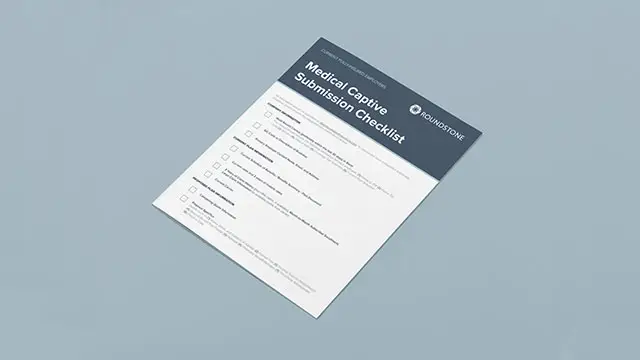- Employers
- Advisors
ADVISORS
Roundstone recognizes and appreciates the important role benefits advisors play — that’s why we only operate through our network of trusted advisors.
- Resources
- Blog
BLOG
Stay up-to-date with the latest trends and learn about how small to midsize businesses can enjoy the benefits of self funded health insurance.
LATEST POST
FEATURED FAVORITES
- About Us
ABOUT US
We are a health benefits captive providing self-funded solutions to small and mid-sized employers. Our self-funded medical group captive bands employers together to fund their benefits the way much larger Fortune 500 companies do.
Find this article helpful? Share it with others.

Stop-loss insurance protects against catastrophic claims and helps manage risk for companies using self-funding. As a group captive insurance plan, stop-loss insurance allows you to enjoy self-funding by pooling resources with other like-sized businesses.
Employers who offer their employees a self-insured health benefits plan should consider adopting a stop-loss policy to get reimbursement for losses stemming from frequent or catastrophic claims.
Running a successful business requires a team of capable workers, and attracting such a workforce often demands employers offer attractive perks, including a comprehensive health insurance plan.
Many small and midsize employers are adopting self-funded insurance plans, which over 80% of large corporations have used for decades. These plans give employers much more control and personalization of their benefits policy compared to the fixed cost of a fully-insured group health insurance plan.
However, self-funding means the employer pays directly for the plan’s health care benefits. While having a benefits package in place is important, employers must also mitigate risk and keep potential losses from large claims in mind.
That’s where a stop-loss insurance plan comes in. With the delivery of stop-loss insurance coverage, even small and midsize businesses can absorb losses from a bad claims year. A stop-loss captive levels risk so that small to midsize businesses can take advantage of the savings of a self-funded health insurance plan.

What is Stop-Loss Insurance?
Stop-loss insurance is for employers to self-fund their health benefit plans. It’s used to hedge against the risk of assuming 100% liability from catastrophic claims. With a self-funded stop-loss insurance policy, insurers are liable for any losses over the set employer deductible.
For small and midsize businesses, this limit can be as low as $10,000. With stop-loss insurance coverage, employers can protect their bottom line. There are two types of stop-loss insurance for employers: specific and aggregate stop-loss.
As part of a group captive insurance plan, stop-loss allows you to benefit from self-funding—all while pooling risk with other businesses.
Specific Stop-Loss Insurance vs. Aggregate Stop-Loss Insurance
“Individual stop-loss,” or Specific Stop-Loss Insurance, provides risk coverage against high-value claims. Rather than protecting against an atypical number of claims, specific stop-loss insurance protects employers against an unusually high claim from a single person.
Aggregate Stop-Loss Insurance covers the total claims of all covered members, rather than individual claims, in a plan year. Aggregate coverage limits losses to a certain amount over a contractual period. If the total claim exceeds the limit, the insurer will reimburse the company.
Some self-funded insurance plans leave all the liability in the hands of employers. But stop-loss protects employers against high or catastrophic claims. This includes all covered individuals with high claims or a frequency of claims.
How Stop-Loss Insurance Works
If several employees at a company contract a virus, or two or three employees develop a major disease or illness, this could result in high claims. A single cancer claim can cost around $41,800 for initial care and $105,500 in the last year of care.
This can result in hundreds of thousands of dollars in medical care across your company. A group stop-loss insurance plan protects the employer from these losses.
Essentially, stop-loss insurance is a tool used by employers to mitigate against the risk of catastrophic financial loss. Losses are capped at a certain amount, and any costs in excess of contracted limits are covered by the stop-loss insurer.
If you’re considering self-funded group captive insurance, it’s important to understand the mechanics. For a better view of how the two work together, let’s take a look at self-insured group captives and why they make sense for small and midsize companies.

Rising Insurance Costs
You are, no doubt, aware of the increasing cost of health insurance. Employers who have a health benefits plan for their employees are often forced to pay fixed-cost premiums. This is especially true during years when the number of claims is particularly high.
This leaves employers burdened with increasing premiums, deductibles, and copays. For this reason, an increasing number of employers are looking for better alternatives to traditional fixed-cost health insurance. For these reasons, self-funded employee benefits plans are gaining in popularity.
Sharing the Risk
With a group captive, self-funded insurance plans enable employers to share risk,. This makes it an attractive option for small and mid-size companies that do not have the scale to self-insure alone. Self-funding through a group captive also offers greater flexibility and control to help companies with cost savings.
Stop-loss coverage is a critical component of a self-funded health insurance plan. The stop-loss policy covers claims above the plan’s specified limit. The claims fund of a self-funded employer will pay claims up to the predetermined deductible for each of the company’s covered employees.
The role of the stop-loss is to cover all claims above these deductible levels. When added to a group captive plan, stop-loss spreads the risk of catastrophic claims over all participants, decreasing costs and volatility.
Join Our Newsletter
Sign up for fresh insights straight to your inbox.
Why Choose Roundstone For Self-Funded Group Captive Insurance?
For decades, Roundstone has offered self-insured group medical captive insurance to employers. The following are a few benefits that coverage with Roundstone offers your company.

1. Freedom of Choice
Though no two companies are alike, it’s standard for insurers to offer a limited number of solutions. At Roundstone, we recognize that every company is unique. We take the time to get to know your company and its unique needs. We then use that information to help you create a plan tailored to your business. You have complete freedom and control over plan design, a TPA and PBM, and cost containment solutions.
More customized health benefits programs benefit your employees, and it is more attractive to potential new hires as well.
2. Affordable Health Insurance
Medical care and health insurance costs are rising, with double-digit increases over the past few years. This has left employers paying out sizable contributions. While many Americans depend on their employers’ health benefits, smaller-scale companies can’t manage the expense.
As healthcare costs far outpace wages, many companies feel forced to shift increases onto their workforce. This occurs through an increased share of their premiums and higher deductibles and copays. Doing so can negatively impact attracting and retaining good workers.
Roundstone’s self-funded health insurance plans through a stop-loss captive save employers 20% on average over fully insured plans. Self-insurance enables employers to provide high-quality care at a lower price.
With Roundstone, we guarantee savings. In the first five years, you’ll save money over a fully insured plan, or we’ll make up the difference. Two-thirds of Roundstone customers save enough in their first four years to completely pay for their fifth year of claims. And 100% save money, full stop
3. Lower Out-of-Pocket Costs
Often, employees are either unable or unwilling to assume the added financial burden. Many abandon their current employment in search of a job that provides more comprehensive care for less. A self-funded group captive insurance plan is a viable solution.
4. Greater Transparency
It’s common for employers not to know what their current health care plan covers and where their claims dollars go. They receive an invoice from their insurers and are unsure what they’re covered for and how much. Many insurance carriers consider this information a trade secret and leave employers guessing on how they spend their insurance dollars.
With a group captive insurance solution from Roundstone, you will have total data transparency and control. A self-funded group captive insurance pan with Roundstone allos you to have direct access to the the data you need to understand your claims dollar spend. This way, you’re not making a worthless attempt to get claims data from your insurance company. This data can help inform your plan, allowing for greater savings and care quality.
You’ll have access to the CSI Dashboard, an analytics platform. The Dashboard details and lays out your claims data. This platform can also help identify cost containment improvements.
5. Better Cost Control and Access to Expertise
A fully customized plan means you’ll have total control over the plan that is best suited for your company.
Not only can you choose your third-party administrator (TPA) and pharmacy benefits manager (PBM), you also decide how to divide your funds based on how your workforce uses their benefits. Control most of your spending. With only a 15% fixed premium, you have a say in how you spend the other 85%.
This is in contrast to fully insured plans, which come with costs that are 100% fixed. With a group captive solution, you’ll have plenty of cost-control options. Plus expert assistance to help identify them.
Roundstone has offered captive insurance for 20+ years. As an Inc. 500 company, Roundstone has health insurance expertise to help you create a cost-effective, custom solution. Benefit both you and your employees when you work with us.
Want to find out if you’re a good fit for a self-funded plan? Download our checklist to help you decide.
Stop-Loss Insurance FAQs
Read more below to explore some common questions about stop-loss insurance.
Stop-loss health insurance is like a safety net for self-funded employers who pay for their employees’ medical claims. If an employee’s medical expenses exceed a certain amount, this insurance covers the extra costs. It helps employers manage unexpectedly high medical costs.
Employers buy stop-loss insurance to protect themselves from huge medical claims related to their employee health benefits plans.
Specific stop-loss insurance covers the cost of a single employee’s expensive claim. Aggregate stop-loss insurance protects against the combined cost of everyone’s claims over a set amount within the policy year. This provides protection against increases in individual and group-level costs.
Self-funding with stop-loss insurance gives employers greater control and security over their health benefits. This can save your company money long term since you only pay for the healthcare services your employees actually use.
Stop-loss insurance costs depend on the group’s size, how much the deductible is, and how healthy your employees are. A customized solution can help you provide coverage that addresses the specific needs of your employees while controlling costs.
Both large and small companies can benefit from stop-loss insurance as long as they have self-funded health plans. Roundstone’s solution works best for companies that have between 25 and 1,000 employees.
As an example, if a self-insured company has set a $50,000 stop-loss limit per employee and one employee incurs $100,000 in medical bills due to a major surgery, the stop-loss insurance would cover the excess $50,000.
Similarly, if the company has an aggregate limit of $300,000 but the total of claims from all employees is $375,000 for the year, stop-loss would cover the additional $75,000.
There is no waiting period for stop-loss coverage to take effect. It is effective as of the policy effective date.
ABOUT THE AUTHOR

Roundstone Team
Enjoy Reading?
Check out these similar posts.
Roundstone Insurance © 2025










